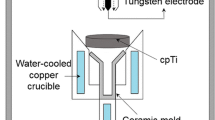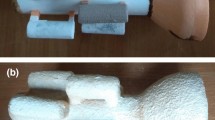Abstract
The interfacial reactions of titanium with investment molds containing alpha-case compound systems were studied. Especially, the alumina molds that are containing titania which is one of the alpha-case compounds were used as a mold material for the alpha-case control. Micro Vickers-hardness and microstructure was analyzed for evaluation of reactivity of titanium with mold material. It was found that the thickness of the alpha-case was effectively reduced, indicating that the titania in the mold can increase the inertness of the alumina mold. The microstructural and compositional characterizations of molds were also analyzed for confirming effect of alpha-case control mechanism. The composition of the mold surface turns titania into oxygen-deficient titania which act as effective barrier on the mold element diffusion.
Therefore, the based on the thickness of the alpha-case and the maximum hardness of titanium castings, alumina mold containing titania may be the best choice for titanium investment casting.
Access this chapter
Tax calculation will be finalised at checkout
Purchases are for personal use only
Preview
Unable to display preview. Download preview PDF.
Similar content being viewed by others
Reference
C.C. Hung, P.L. Lai, C.C. Tsai, T.K. Huang and Y.Y. Liao, “ Pure titanium casting into titanium-modified calcia-based and magnesia-based investment molds,” Mater. Sci. Eng. 454–455 (2007), 178–182.
W. J. Boettinger, M. E. Williams, S. R. Coriell, U. R. Kattenr, and B.A. Mueller, “Alpha Case Thickness Modeling in Investment Castings,” Metall. Mater. Trans. 31 (B) (2000), 1419–1427
S. Jones, C. Yuan, “Advances in shell moulding for investment casting,” J. Mater. Process. Tech. 135 (2003), 258–265
Matthew J. Donachie, Jr. Titanium a technical guide 2 nd, 2000
Y. W. Chang and C. C. Lin, “Compositional Dependence of Phase Formation Mechanisms at the Interface Between Titanium and Calcia-Stabilized Zirconia at 1550oC,” J. Am. Ceram. Soc. 93 (2010), 3893–3901.
R. L. Saha, R. D. K. Misra, “Formation of low-melting eutectic at the metal-mould interface during titanium casting in zircon sand moulds,” J. Mater. Sci Letters. 10 (1991), 1318–1319.
C. Frueh, D. R. Poirier and M.C. Maguire, “The Effect of Silica-Containing Binders on the Titanium/Face Coat Reaction,” Metall. Mater. Trans. 28 (B) (1997), 919–916.
R. L. Saha, T. K. Nandy, R. D. K. Misra, and K. T. Jacob, “On the Evaluation of Stability of Rare Earth Oxides as Face Coats for Investment Casting of Titanium,” Metall. Mater. Trans. 21 (B) (1990), 559–556.
P. Kofstad, P. B. Anderson and O. J. Krudtaa, “Oxidation of titanium in the temperature range 800–1200°C,” J. less-common metals. 3 (1961), 89–97
I. Barin, Thermochemical Data of Pure Substances, 1994
L. D. Teng, F.M. Wang, W.C. Li, “Thermodynamics and microstructure of Ti–ZrO2 metal–ceramic functionally graded materials,” Mater. Sci. Eng, 293 (A) (2000), 130–136
Z. Liu and G. Welsch, “Literature Survey on Diffusivities of Oxygen, Aluminum, and Vanadium in Alpha Titanium, Beta Titanium, and in Rutile,” Metall. Trans. 19 (A) (1988) 1121–1125.
E. A. Branded and G. B. Brook, Smithells Metals Reference Book, 7th ed., Butterworth-Heinemann Ltd., UK (1992).
S. Y. Sung, Y. J. Kim, “Alpha-case formation mechanism on titanium investment castings,” Mater. Sci. Eng, 405 (A) (2005), 173–177
ASM Handbook 3, (The materials information company 1992)
E. A. Branded and G. B. Brook, Smithells Metals Reference Book, 7th ed., Butterworth-Heinemann Ltd., UK (1992)
Oleg N. Senkov, Daniel B. Miracle, Sergey A. Firstov, Metallic Materials with High Structural Efficiency, (2004), 287– 308
L. N. Belyanchikov, “Thermodynamics of Titanium-Based Melts: II. Oxygen in Liquid Titanium,” Metall., 2010 (2010), 1156–1163.
Author information
Authors and Affiliations
Editor information
Editors and Affiliations
Rights and permissions
Copyright information
© 2013 TMS (The Minerals, Metals & Materials Society)
About this paper
Cite this paper
Seul, L., Choi, BJ., Youn, JI., Kim, YJ. (2013). Characterization of the Interfacial Reaction between Titanium Castings and Alumina Mold Containing the Alpha-Case Compounds. In: Krane, M.J.M., Jardy, A., Williamson, R.L., Beaman, J.J. (eds) Proceedings of the 2013 International Symposium on Liquid Metal Processing & Casting. Springer, Cham. https://doi.org/10.1007/978-3-319-48102-9_50
Download citation
DOI: https://doi.org/10.1007/978-3-319-48102-9_50
Publisher Name: Springer, Cham
Print ISBN: 978-3-319-48587-4
Online ISBN: 978-3-319-48102-9
eBook Packages: Chemistry and Materials ScienceChemistry and Material Science (R0)




